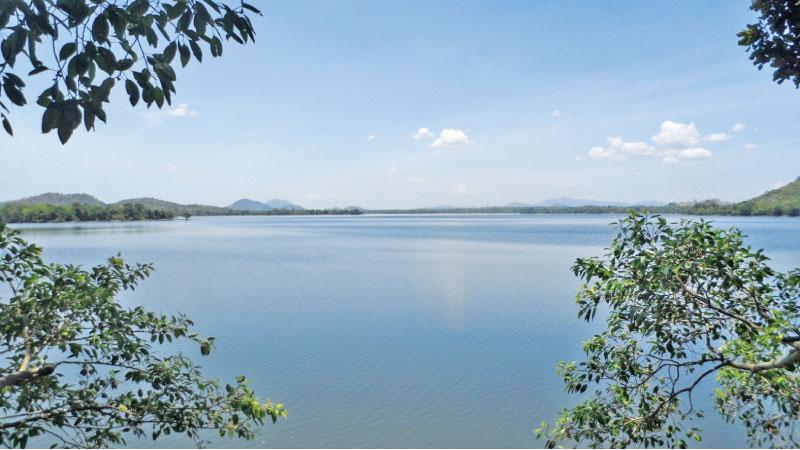
Sorabora Wewa is located in Mahiyangana and is believed to have been built by a giant named Bulatha during the reign of King Dutugemunu (161-137 BC) in the second century BC. It is located in Mahiyangana about 2-3 km away from the town of Mahiyangana. Also known as the Sea of Bintenna, Sorabora Wewa is one of the earliest tanks to be built in Sri Lanka and is one of the oldest civilisations in the country.
Bulatha the giant got his name as he had to provide bulath (betel leaves ) to the King. He also had to prepare seven chews of betel at different times daily for the King. Another story says that King Dutugemunu on the way to battle with King Elara in Anuradhapura camped at a place named Kadali Pathra (present Keselpatha) close to Mahiyangana.
It was here that Bulatha (Balathirala), a villager from the village, Kiripattiya, Ududumbara joined the king. 
King Dutugemunu ordered Bulatha to collect treacle from Meemure, betel from Kevulgama, arecanut from Puwakpitiya and milk from his own village, Kiripattiya.
Bulatha had to travel in mountainous areas with dangerous paths to collect these items including the Kosgolla mountain pass which linked Ududumbara and Minipe. While travelling to and fro Bulatha saw a river flowing through a low land which lay between two mountains and got the great idea of building a tank by damming the river and getting water to irrigate paddy fields.
Bulatha started on his tremendous task. After his daily trip to the Royal Palace he started to build the embankment across two hills single handedly. He kept bringing the necessary materials to the spot where he was going to build the dam on his journey’s to and fro from the Royal Palace.
Legend has it that Bulatha was so strong that he had to use a mammoty that was ten times larger than the normal mammoty and that the basket he used to remove earth was equally large.
Bulatha’s wife brought him his food while he was working on the dam in Mahiyangana from their village, Kiripattiya twice daily. She had to travel through the dangerous Kosgolla pass and when she saw the hundreds of devotees going to worship at the Mahiyangana Raja Maha Viharaya she decided to build a flight of steps over this path to make it easier for the pilgrims. It is said that she had the strength of 20 women and that she built a few stone steps at a time daily.
After the completion of the dam and tank Bulatha invited King Dutugamunu to see his work and open the dam and tank. This was on the day that the King opened the renovated Mahiyangana Raja Maha Viharaya. An amazed King could not believe that Bulatha had done this massive task to help the surrounding villages by himself. It was at this moment that the King realised that Bulatha was a giant. Some legends say that the King was very happy with Bulatha’s great feat and put his royal cape on him, made him a general in the King’s army and presented him a village named Udathwewa.
However, other historical stories tell a sad tale. According to these the King resented and was jealous of Bulatha’s mighty deed. So, he got Bulatha beheaded and thrown into the very tank that Bulatha built. These terrible deeds were done in secret. Bulatha’s blood is supposed to have made the water murky or unclear.
The tank’s name is supposed to have come from this gruesome deed. The Sinhala word for secret is hora and the word for murky is bora.
As Bulatha was killed in secret and his blood made the water murky the tank was called Horabora Wewa. Overtime Horabora changed to Sorabora,the name by which the tank is known today.
Sorabora Wewa
The Sorabora Tank has been built by damming a river named Diyawanna Oya. The embankment is 1590 feet (485 metres) high. The tank is 1,100 acres or 4.5 sq kms in extent . The water volume at full capacity 14.6 million cubic feet (11,800 acre-feet). The sluice gates are not cut into the embankment but are expertly cut in to the natural rock and are about five feet in width.
Sorabora Wewa is unusual in that it does not have a Bisokotuwa like other tanks. A Bisokotuwa (silt-trap) is a deep square well built to regulate the water pressure at the sluice gates inside the tank thus protecting the embankment from erosion. Since the Sorabora Wewa sluice gates were not cut into the embankment and therefore, it was not in danger of erosion the need for a Bisokotuwa did not arise say experts.
The ruins of a tank similar to Sorabora Wewa, again without a Bisokotuwa is located near Udathwewa , the village supposed to be gifted by King Dutugamunu to Bulatha. It is thought that this tank too may be a creation of the giant, Bulatha.
